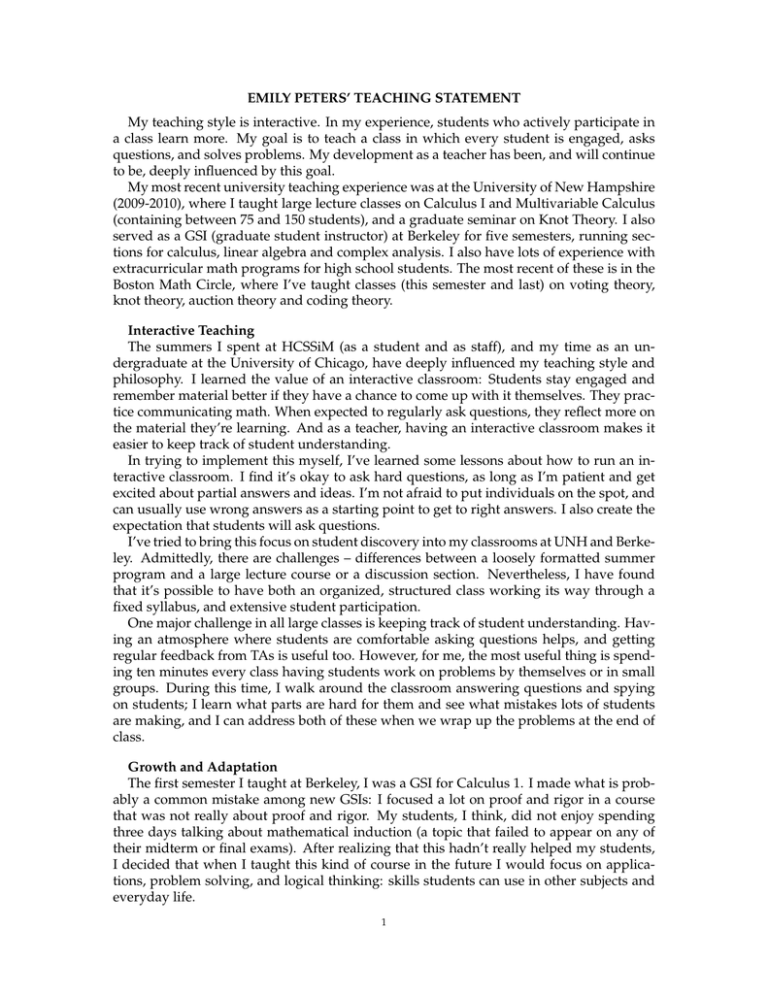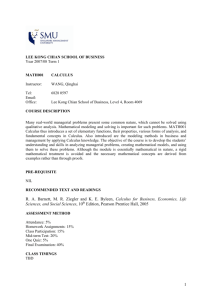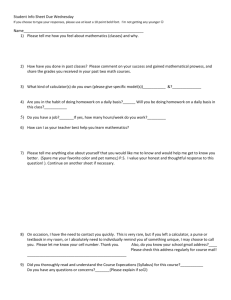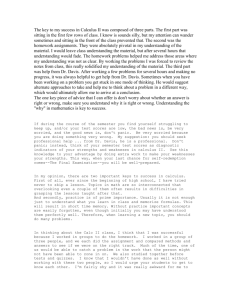EMILY PETERS’ TEACHING STATEMENT
advertisement

EMILY PETERS’ TEACHING STATEMENT My teaching style is interactive. In my experience, students who actively participate in a class learn more. My goal is to teach a class in which every student is engaged, asks questions, and solves problems. My development as a teacher has been, and will continue to be, deeply influenced by this goal. My most recent university teaching experience was at the University of New Hampshire (2009-2010), where I taught large lecture classes on Calculus I and Multivariable Calculus (containing between 75 and 150 students), and a graduate seminar on Knot Theory. I also served as a GSI (graduate student instructor) at Berkeley for five semesters, running sections for calculus, linear algebra and complex analysis. I also have lots of experience with extracurricular math programs for high school students. The most recent of these is in the Boston Math Circle, where I’ve taught classes (this semester and last) on voting theory, knot theory, auction theory and coding theory. Interactive Teaching The summers I spent at HCSSiM (as a student and as staff), and my time as an undergraduate at the University of Chicago, have deeply influenced my teaching style and philosophy. I learned the value of an interactive classroom: Students stay engaged and remember material better if they have a chance to come up with it themselves. They practice communicating math. When expected to regularly ask questions, they reflect more on the material they’re learning. And as a teacher, having an interactive classroom makes it easier to keep track of student understanding. In trying to implement this myself, I’ve learned some lessons about how to run an interactive classroom. I find it’s okay to ask hard questions, as long as I’m patient and get excited about partial answers and ideas. I’m not afraid to put individuals on the spot, and can usually use wrong answers as a starting point to get to right answers. I also create the expectation that students will ask questions. I’ve tried to bring this focus on student discovery into my classrooms at UNH and Berkeley. Admittedly, there are challenges – differences between a loosely formatted summer program and a large lecture course or a discussion section. Nevertheless, I have found that it’s possible to have both an organized, structured class working its way through a fixed syllabus, and extensive student participation. One major challenge in all large classes is keeping track of student understanding. Having an atmosphere where students are comfortable asking questions helps, and getting regular feedback from TAs is useful too. However, for me, the most useful thing is spending ten minutes every class having students work on problems by themselves or in small groups. During this time, I walk around the classroom answering questions and spying on students; I learn what parts are hard for them and see what mistakes lots of students are making, and I can address both of these when we wrap up the problems at the end of class. Growth and Adaptation The first semester I taught at Berkeley, I was a GSI for Calculus 1. I made what is probably a common mistake among new GSIs: I focused a lot on proof and rigor in a course that was not really about proof and rigor. My students, I think, did not enjoy spending three days talking about mathematical induction (a topic that failed to appear on any of their midterm or final exams). After realizing that this hadn’t really helped my students, I decided that when I taught this kind of course in the future I would focus on applications, problem solving, and logical thinking: skills students can use in other subjects and everyday life. 1 I still occasionally want to talk about a particular proof in class. When this happens, it’s because I believe the proof can contribute significantly to students’ understanding of the material. In this case, simply avoiding the word proof and talking about why something is true, and how it works, seems to make students more receptive. For example, in calculus classes, I’ve had great discussions that started with “let’s talk about why the fundamental theorem of calculus works.” Another important aspect of my teaching is that I emphasize that there is rarely a single correct way to do a problem or think about a theorem. This means that, when introducing a new concept, I’ll make sure students begin with an example, see a formal statement, hear an informal discussion of what it actually means, and draw an illustrative picture (on occasion, funny noises and wild gesticulation have also proved pedagogically useful). Also, when we solve a problem in class that’s not entirely straightforward, I try to present (or get students to present) at least two different solutions. Students become more courageous problem solvers when they understand that there is more than one correct way to approach a problem or idea. Mentoring and other skills At UNH, I also had the pleasure of working closely with graduate students, both as students and as teaching assistants. At the request of students, I organized a weekly seminar on knot theory in which we read an introductory paper on Khovanov homology and enough material on the hyperbolic volume of knot complements to state the volume conjecture. I gave slightly less than half of the talks; the other talks were given by students in the class. Many of the students in this seminar were in their first or second year of graduate school and had never given a mathematical talk before. I worked closely with these students in preparation for their talks and made sure to discuss what makes a mathematical talk useful to the audience, as well as the mathematical content of their chosen topics. Their course evaluations made it clear that they found the experience very rewarding. In each of the UNH classes for undergraduates that I taught, I had one or two graduate student TAs who ran recitation sections. I had (brief) weekly meetings with them, to make sure they knew what I was doing in lecture; I knew what they were doing in sections; and so that we could share our impressions of the students’ progress that week and performance on quizzes and homework. I also offered to watch them teach a section, and provide feedback, and most of them took me up on this offer. This was another opportunity for me to emphasize the difference between good mathematics, and good mathematical communication. In at least one case, I think the TA and his students benefited significantly from my feedback; I encouraged him to use signposts like “theorem” or “counter-example” in his boardwork, and had fewer student complaints about his sections afterwards. I also had multiple opportunities at UNH to develop managerial skills related to teaching. With my large classes, I had ample opportunity to get to know the Blackboard software. I also used internet-based homework programs in both of my introductory calculus classes. In one class I used WebWork (a free open-source program supported by the MAA and NSF), and in the other class I used MyMathLab (provided by the publisher of our textbook). In Spring 2010, I served as course coordinator for the three different lecture sections of Calculus I; this involved taking the lead in preparing the syllabus, setting grading policies, and writing exams which were used by all three of us lead instructors. I’ve learned a lot from all of the classes that I’ve taught, and in different ways, I’ve really enjoyed all of them. I have experience with a wide range of classes and students, and I’m confident that I will continue to learn from and enjoy teaching at your university. 2




